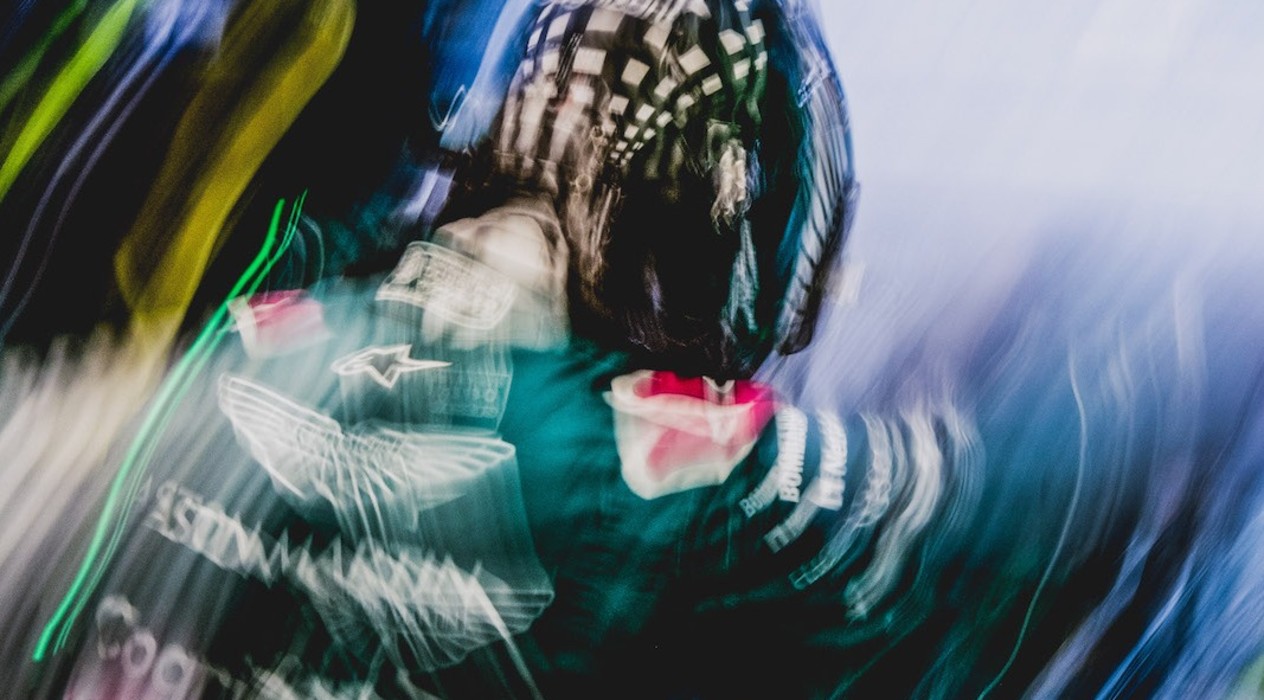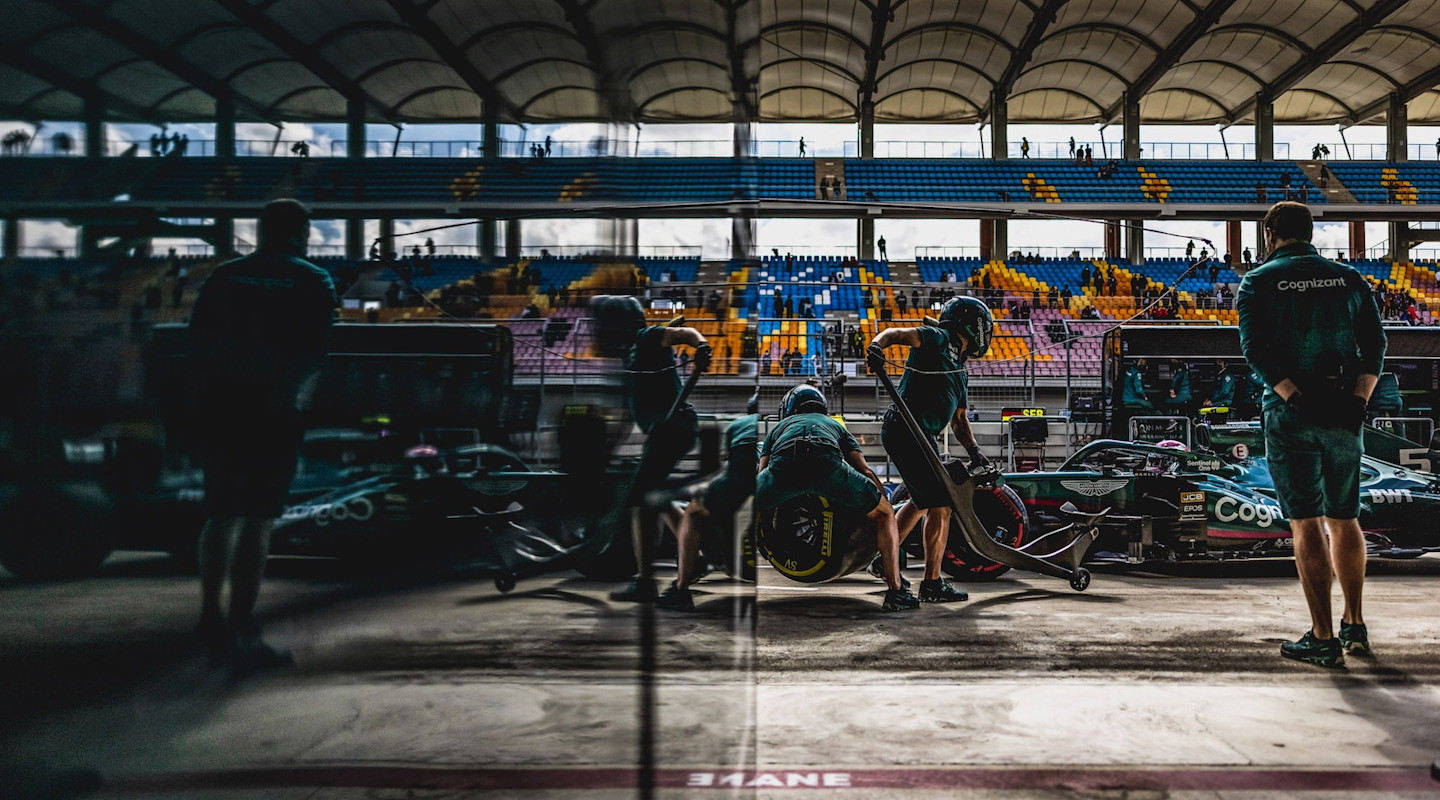
From tracking cars at high-speed, tackling some of the most iconic circuits in world motorsport, to capturing intimate behind-the-scenes shots of team members working tirelessly in the garage, photographers have a front-row seat for the very best of the F1 action.
In the first of a new series, we're sitting down with Aston Martin Cognizant Formula One™ Team and Motorsport Images Photographer Glenn Dunbar to share his experiences from a career in the fast lane and get a few tips and tricks for aspiring Grand Prix photographers around the world.
"My father inspired my career, as he used to be a Formula One photographer," says Glenn. "He had a great life, travelling the world, taking pictures of racing cars. What young boy wouldn't dream of doing the same?
"I learned a lot about photography from him, and still do."
Glenn worked his way up the ladder to Formula One, beginning with a spell in the darkroom at a photo agency, learning the principles of processing and printing.
Seizing any opportunities to go to live events and shoot, Glenn's time with a London agency led to covering horse racing, darts, ladies' golf and more, including F1 testing and MotoGP events.
"I got where I am today by starting at the bottom and working my way up," adds Glenn. "There's no better way to grow."
During the global pandemic, Glenn was and remains embedded within the team. And while COVID restrictions have prevented him being able to shoot trackside, he has found himself getting closer than ever before to the men and women at the heart of the action in the garage.
What's more, with his movements outside of the garage limited, Glenn has had to get creative to shoot the AMR21 from specific vantage points, such as the top of the team's garage.
Such a wide range of photo opportunities requires a wide range of equipment, with Glenn adding that a Grand Prix photographer needs "everything from a wide-angle lens to a medium-range telephoto lens, and a fixed prime long lens."
Photographing a Grand Prix
Team photographer Glenn Dunbar shares a behind-the-scenes look at the equipment he needs to cover a Grand Prix from every angle.

While some of the most famous moments in Grand Prix history have been recorded on camera, there's more to the role than standing trackside, hoping to catch something memorable.
Starting with Thursday’s media day, Glenn follows the drivers to create portraits and fulfil requests for the team's partners.
Fridays and Saturdays have evolved during the pandemic, but are usually spent collecting 'stock' imagery which highlights the beauty of the car and its sponsors, in addition to photographing sponsor representatives and other VIP guests of the team in attendance.
Glenn describes Sunday's Grand Prix as a "one-and-a-half-hour session" to shoot between the cars lining up on the grid and the traditional post-race events, including the podium ceremony.
For any aspiring photographers, Glenn recommends getting the basics right first, before unleashing your creativity.
"Stock images might be easy to gather, but they're important for clients like a racing team. That's something that is often missed by budding photographers, who focus on the artistic, fuzzy, blurry images over the basics.
"Once you're able to shoot stock-style images, you can really focus on the creative stuff. With the advent of social media, the artistic shots can be really popular, but there's a balancing act each weekend.
"The quicker you do the stock shots, the more time and space you have to experiment and try to create something new and unique.”
It's this experimentation and creativity that we're showcasing in Shutter Speed. Glenn has chosen six images from the Turkish Grand Prix, and he explains the techniques, meaning and set-up behind each shot.

Shot on a Canon EOS 1D X Mark II fitted with a 70-200mm lens, F2.8L
"When the weather conditions change and you have a wet track you know there's going to be spray, and that's a lovely and dramatic element to include in your photography.
"There were two opportunities to do this over the weekend, on Saturday and Sunday. I was on the roof for the first five laps.
"I knew that this angle works well, so this shot was pre-planned and calculated."

Shot on a Canon EOS 1D X Mark II fitted with a 70-200mm lens, F2.8L
"With a detail shot like this, you always want to try and tell a story. The image of raindrops falling on the nosecone is such a pleasing shot.
"You'd think it was quite an easy shot to do, but it's not. The cars are kept out of the rain as much as possible, so there’s only a small window to take it.
"During the rain on Saturday, I was able to grab the shot just as they were about to take the car back from a practice pitstop.
"I had a few seconds to take this shot, and I zoomed almost all the way in with the lens. The ability to play with lenses and focal lengths helps create different effects."

Shot on a Canon EOS R5 fitted with a 28-70mm lens, F2L
"For a wet race, the teams will put up a tent over the cars, which creates dark lighting and a moody effect.
"I was waiting at the front of Lance's grid position, waiting for him to come in, and I was planning to shoot him head-on as he was getting out of the car.
"But when the mechanics attached the blowers to keep the car cool and used dry ice, I saw this dry ice steam vapour, and I thought ‘let's do something different’.
"The side of the car is a more dramatic composition, and it makes Lance look a little bit more gladiatorial.
"It's those images that reward you for being on your toes and making the best of a situation."

Shot on a Canon EOS R5 fitted with a 28-70mm lens, F2L, using a neutral density filter
"This is a shot that's all about having time to experiment. I think this was during FP3. As a team photographer under COVID restrictions, I'm not trackside, so I have time to experiment in the garage.
"I'd done shots like this with the driver facing forward and sat in the car, but I wanted to try a rear three-quarter angle and give off the sensation of speed, even if the driver is just climbing in.
"The key was to use a slow shutter speed, keeping the focal point on Lance but aimed at the Aston Martin logo on his back.
"It's a different shot and not one you see every day. It's more of a striking social-media-style image."

Shot on a Canon EOS R5 fitted with a 28-70mm lens, F2L
"So, for this shot, it's quite different. The garage is so busy during a race weekend, with a lot of people going about their jobs, so you never really get the chance to shoot one person in their element alone.
"I'd been trying to do this shot for a while. To get a driver walking from the back of the garage towards the car is really cool.
"For me, this is like a visual representation of the fact that when it comes down to it on track, it's the driver who makes the difference.
"I really think this image reflects a lone warrior vibe."

Shot on a Canon EOS R5 fitted with a 28-70mm lens, F2L
"We've got some dark panelling in the garage, which really lends itself to reflective shots. So, I thought I'd experiment when the car arrived in the pit box.
"I thought it was either going to work really well or not work, but it was worth an experiment. I'd shot a few of Lance coming in, but then I was able to get this shot of Seb and his helmet really works in the reflection.
"I like how we have the mechanic to the side, looking over. It gives a different angle to the weekend compared to what most people see.”
"It's nice to take a step back and show the weekend in a more creative way. I found this to be a really pleasing shot to the eye and I hope those seeing it do too!"
Thanks to Glenn Dunbar for sharing his passion and creative talents: #IAMCREATIVITY. You can discover Glenn's photography on his Instagram page: @glenn_dunbar.
All in. All welcome. All celebrated. Sign up to open up a world of I / AM benefits and once-in-a-lifetime experiences.




























